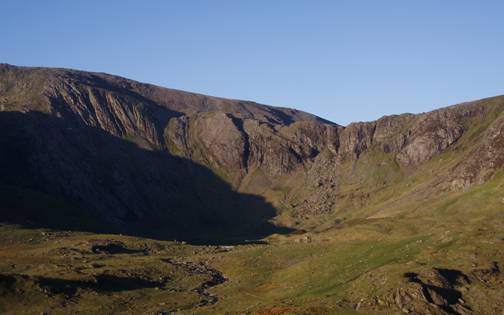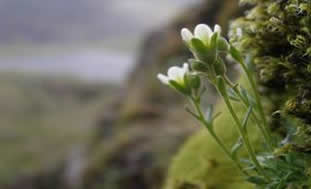UK: Is it getting too warm for the Tufted Saxifrage?
01.09.10 by Pete Kay and Tom Deacon
A case study looking at the possible impacts of climate change on a rare Arctic alpine plant clinging on for survival in the rugged mountains of North Wales...
Cwm Idwal, set deep into the north-eastern face of the Glydr mountain range in Snowdonia National Park, is a much studied example of a glacial cwm or corrie. Often described as a large ‘armchair shaped hollow’ formed by the erosive power of glacial ice during a series of glaciations spanning back almost 2 million years, this deep glacial cwm has drawn scientists and visitors alike for hundreds of years. Charles Darwin was one of many scientists to visit Cwm Idwal in the early 1800s, commenting in his diary on the richness of plant life and complexity of the geology, but chiding himself for failing to notice upon first visiting the role ice had played in forming this majestic landscape.

An early morning view southwest across the Ogwen valley into Cwm Idwal
© Tom Deacon
Cwm Idwal was designated a National Nature Reserve (NNR) in 1954, the first in Wales, and is now visited by approximately half a million people each year (including many school and university groups). The site is managed by the Countryside Council for Wales (CCW) in partnership with the owners, the National Trust, the tenant farmer and the Snowdonia National Park Authority. Cwm Idwal is protected for its unique geology, awe-inspiring post glacial landscape, and its oligotrophic (low nutrient) lake (Llyn Idwal) with its rare benthic plant communities, and the incredibly rare arctic alpine flora living high on the rocky back wall.
Tufted saxifrage (Saxifraga cespitosa) is the rarest of the many rare plant species found at the site. It’s commonly found in the tundra and mountains of the Arctic Circle where it grows and thrives on glacial gravels and the bleak shores of Lapland, Canada, Siberia and Norway. Found on the most northerly point of land on the planet, it is a serious plant of the Arctic adapted to a life of extreme conditions and very little competition from other plants.
 Tufted saxifrage growing on the back wall of Cwm Idwal © Pete Kay
Tufted saxifrage growing on the back wall of Cwm Idwal © Pete Kay
At the end of the last glaciation, as the ice melted, Britain became a landscape of tundra vegetation similar to conditions found currently in the Arctic Circle. For a short time plants like the tufted saxifrage thrived here, however, within a couple of thousand years, plants colonised the land from further south and soils slowly developed. Most of the UK became covered in dense woodland and many Arctic species were out-competed by faster growing, more competitive plants, and became extinct over most these islands.
That said, in a very few north-facing, high-altitude areas where the soil is thin and rocky and woodland prevented from establishing - and the cold temperatures and shade prevented many plants from thriving - relicts of these Arctic plant communities survived. One such place is the back wall of Cwm Idwal - some of the Arctic plants found here are some of the rarest and most threatened plants in the UK living ever closer to the brink of extinction – but as the climate warms it enables more competitive plants to thrive in this once extreme mountain environment.
For the tufted saxifrage Cwm Idwal is the southern limit for this plant in Europe; in fact Cwm Idwal is the only place in England and Wales where it is still found. As such this site and the mountains of Snowdonia may be regarded as the southernmost outpost of Arctic conditions on our continent and a site very sensitive to climatic changes. Many of the Arctic plants in Cwm Idwal are genetically unique having been isolated from other plants of the same species for many thousands of years.
Tufted saxifrage has been recorded by botanists and plant collectors at Cwm Idwal since its discovery there in 1778, though it has always been a very elusive and rare plant. Unfortunately by 1976 due to plant collectors and later by subsidy driven overgrazing there were only two small clumps of the plant left and one of these clumps died in the long hot summer of that year. A last ditch rescue mission was launched to save the Welsh tufted saxifrage from extinction.
Seeds from the remaining plant were collected and grown at the University of Liverpool Botanical Gardens at Ness. This wasn’t an easy task, but with great care the seedlings flourished and 30,000 seeds were produced by the new plants. Some went to the seed bank at Kew and some were re-introduced to Cwm Idwal with the aim of bringing the population back to its pre-collection and overgrazing levels of about 50 plants in all (calculated from the dry and dusty museum specimens collected and recorded from the site by Victorian botanists).
However, Nature was not so obliging… of the 100 or so specimens planted out back into Cwm Idwal only half survived the first two years of their reintroduction. By 1994 only 11 of the reintroduced plants survived and in 2010 only 3 survive as well as the original parent plant which must be of a great age. The last few decades of mild and wet summers and winters have really taken their toll on this organism adapted to life in the extremes of the Arctic. There are no further plans to reintroduce the tufted saxifrage to the site as the reintroduced plants have failed to establish ecologists have decided the habitat is no longer suitable. Sadly, it looks like the existence of this beautiful plant in Wales, a species that has been present in the British Isles as long as, if not longer than, any other plant species is likely to be ending very, very soon.
Pete Kay and Tom Deacon work for the Field Studies Council at Rhyd-y-Creuau, Snowdonia. The Field Studies Council is one of the most important organisations in the UK helping people to understand, and be inspired by, the natural world.
Related links:
Ascension Island: Hooker’s lost parsley fern found on mountain
17.08.10 by Stedson Stroud and Olivia Renshaw
On 27 July 2009, the Ascension Island Government’s Conservation Team were conducting a routine annual plant census with botanist Dr. Phil Lambdon. “We were exploring a narrow ridge on the southern side of Green Mountain. By chance, Phil and I noticed a tiny frond sticking out of a crevice in the rock." Stedson Stroud and Olivia Renshaw tell the story of their chance discovery.
UK IN PICTURES: Conserving plants on the UK's most southerly tip
30.06.10
The coastal grasslands of the Lizard, Cornwall are some of the most diverse plant habitats in the country. Here, unusual geology combines with a mild climate and a remote and ancient agricultural landscape to foster many species that are found nowhere else.
UK: Lower plant strategy for Wales
09.09.09
 The mosses, lichens and liverworts - collectively known as lower plants - in alliance with fungi (and those who study them!) are the unsung heroes of natural history. So a new strategy produced by the wild plant charity Plantlife in conjunction with Plant Link Cymru comes as good news for fans of these strange beings.
The mosses, lichens and liverworts - collectively known as lower plants - in alliance with fungi (and those who study them!) are the unsung heroes of natural history. So a new strategy produced by the wild plant charity Plantlife in conjunction with Plant Link Cymru comes as good news for fans of these strange beings.